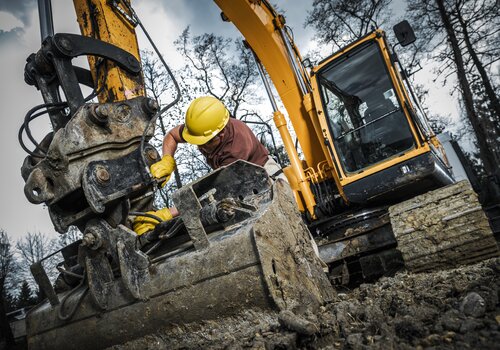Construction sites pose a lot of risks to the health and safety of people working on them. The most frequent hazards are falls and struck-by. When snow and ice are present, slips, falls, and collisions are more likely to happen.
Here are eight tips for improving safety on your jobsite during winter.
1. Watch weather conditions
Weather conditions and forecasts change, sometimes with little warning. Watching long-term weather forecasts will help you plan what work can be completed productively and safely. From short-term weather forecasts, you can deduce how those conditions will influence your planned work and how you can make site conditions safer.
Check weather forecasts throughout the day. If weather conditions are expected to significantly change from what was stated in your morning meeting, inform them, so they can be better prepared.
“Near the end of each day, I check the long-range and next-day weather forecasts. Then, I get up at 4am and see what weather conditions are actually like by observing local traffic cameras and using weather radar. The weather conditions being reported on the news aren’t necessarily the weather conditions affecting your jobsite even if both are located in the same city,” says Lou Devuonno, Site Supervisor at MGI Construction, Inc.
2. Educate your workforce regarding weather hazards
The best way to keep your workforce safe is to discuss actual and potential weather hazards at the start of the day. How is the site affected and what can employees do about it? Frozen surfaces make it harder to move and flurries make it harder to see. Also, freeze-thaw cycles can cause wet and muddy conditions as well as snowy and icy conditions.
The cold is also a hazard. It can prevent equipment from starting or working properly, which can cause an accident and delay work. And the cold can cause hypothermia and frostbite in people When employees are trained and motivated to make safety a priority. Hypothermia begins with shivering, and the person’s skin turns pale, they slur their speech, and are less able to coordinate. Frostbite begins with skin discoloration—first red then purple then white. Both are serious conditions that require medical treatment and can result in permanent damage if not treated immediately.
3. Ensure people dress appropriately
It’s not enough to tell people to dress in warmer clothes; you need to outline clothing expectations for cold weather work. This often requires dressing in layers and bringing extra clothes in case it gets colder than predicted or if clothing gets wet. Two sets of gloves allow workers who use hand tools to use a slimmer pair when operating the tool and a thicker pair when performing activities
“Construction companies can improve the health of their workers by providing better training for site supervisors and superintendents and couple that with a zero-tolerance approach to violations to decrease the number of incidents on your site,” advises AEC Safety Solutions Inc., a company that has managed the safety programs for more than 1,000 construction projects ranging in size from $100,000 to $75,000,000.
4. Get out of the cold when you can
Even wearing appropriate clothing may not be sufficient protection for all-day protection from the cold. The Occupational Safety and Health Administration (OSHA) mandates employers must provide a warm and safe place for workers. However, regularly scheduled breaks may not provide sufficient time away from the cold. Employees may need to take more regular breaks.
5. Stop the spread of viruses
Although we’re no longer in a pandemic, people still get ill and pass that illness to other people. Advise people of sanitary procedures and provide plenty of opportunities for hand washing and sanitizing.
6. Ensure proper clean up
Examine walkways and work areas. Are they clean from snow, ice, water, and mud? If not, these areas need to be cleared. Invest in the right tools (brushes, brooms, shovels, ice melter, etc.) and ensure people know how to use them.
AEC Safety Solutions says contractors can minimize slips and falls by ensuring paths and walkways are maintained. Assign a worker to clear snow and ice—not just first thing in the morning, but all day. Make it their number one priority.
7. Properly maintain equipment
Equipment can backfire, misfire, or not fire due to cold temperatures. Ice can prevent equipment from operating and cause damage. Damaged equipment is more likely to cause injuries.
Keep equipment indoors or covered when not in use. Visually inspect your equipment every day and give it sufficient time to warm up. Switch to using fluids designed for cold temperatures.
8. Develop an extreme weather emergency response plan
A storm can form with little warning. You should have a plan for what you will do if you see extreme weather will affect your jobsite. The plan should include where people will go and what you will do with equipment.
"This is especially important when working on high-rises. Wind, flurries, and visibility are increased hazards, so you have to watch the weather more regularly and have plans for dealing with adverse weather,” says DeVuono.
If the weather shuts down the site for the rest of the day and people go home, you should have a plan to ensure each employee arrives home safely. Text or call people to check whether they safely made it home.
Read Next
4 Must-Do Steps to Prepare Your Equipment for Winter
Beat Winter with these Snow Removal and Equipment Winterization Tips












